What Do You See?
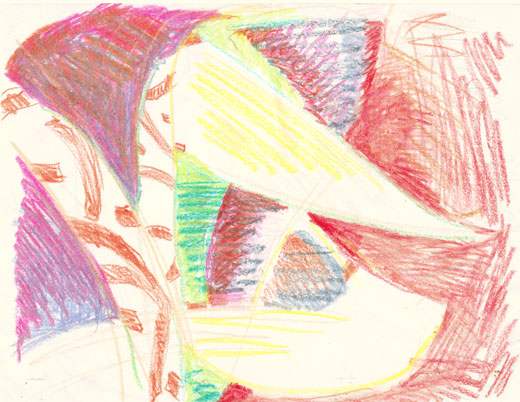
Seems like a good time to ask: “what do you see?” Drawing was started by my daughter and finished up by me.

Seems like a good time to ask: “what do you see?” Drawing was started by my daughter and finished up by me.

Ah, to look back at the early fall garden.

Who sold Joseph? Here’s the pasuk in Vayeshev (Genesis 37:28)-
The straightforward answer, as Rashi sees it, is that the brothers took Joseph out of the pit and sold him to the Ishmaelites and the Ishmaelites to the Midianites and the Midianites to the Egyptians.
I learned from my son, however, (it’s so wonderful when you can learn from your kids) that Rashbam (who is the grandson of Rashi; can you imagine challenging your own scholarly grandfather?) sees this differently. He suggests that the “they” who do the selling are the Midianites: “The brothers sat down to a meal at some distance from the pit, out of qualms of conscience and waited for the Ishmaelites they had seen. But before the latter arrived, others, Midianite traders passed, saw Joseph in the pit and drew him out and sold him to the Ishmaelites, presumably without the knowledge of the brothers.”
This helps explains Genesis 39:1, where Potiphar buys Joseph from the Ishmaelites. Other commentators complain that Rashi does not adequately explain this pasuk (how do the Midianites fit in? Who sold him to Egypt, Midianites or Ishmaelites?). But if the Midianites take Joseph without the brothers knowing and sells him to the Ishmaelites, then this pasuk makes sense.
Much more on this topic in Nehama Leibowitz’s New Studies in Breishit.
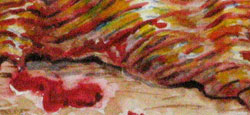 A much simpler question is why does the text in beginning of Miketz say “brothers of Joseph”? Rashi’s explanation is that they went down to Egypt to look for him, that he was very much on their minds (daughter of Mrs. S. said it was out of love for their brother). But if one follows Rashbam’s explanation, that the Midianites sold him and the brothers thought him dead, why does it say “brothers of Joseph”? (I don’t know).
A much simpler question is why does the text in beginning of Miketz say “brothers of Joseph”? Rashi’s explanation is that they went down to Egypt to look for him, that he was very much on their minds (daughter of Mrs. S. said it was out of love for their brother). But if one follows Rashbam’s explanation, that the Midianites sold him and the brothers thought him dead, why does it say “brothers of Joseph”? (I don’t know).
• • •
While we are discussing Joseph, I just want to remark on what Rabbi Levi Meier, z”l, calls “Joseph’s astonishing ability to forgive his brothers.” In his book Ancient Secrets: Using the Stories of the Bible to Improve Our Everyday Lives, Rabbi Meier talks about Fate vs. Destiny: you can have reasons to hold a grudge, you can have a terrible start in life, and you can either sulk and not move forward or you can use it as a way to learn and grow:
Joseph’s forgiving is hard to achieve, especially when you have been terribly wronged by another person. In the case of Joseph, his life could have been ruined by the actions of his brothers. However, it was not, because he did not allow that to happen… Nursing your hurt feelings, your anger, and your bitterness will not bring you to happiness. It will only make you a slave to your fate, and you may never come to know that you could have freed yourself—that you could have been the master of your destiny.
• • •
More interesting posts on this parsha:
Ilana-Davita: Forget All My Father’s House
Aron Grinshtein: Why Couldn’t the Wise Men of Egypt Figure Out the Dreams?
And on last week’s parsha on Tamar:
Shorty: she writes about Tamar and wonders why Rivka and Tamar had to be sneaky. Any ideas for her?
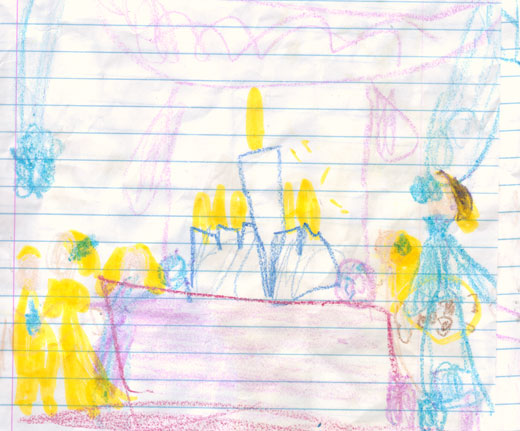
My daughter gave me a book of her drawings as a Chanukah present. I am supposed to write in the story myself.
Can you help me? Is this a queen or a princess? Who are those folks in yellow? Is that a cake in the middle? A castle? A cake of a castle? Oh, maybe it’s a chanukiah (a menorah)! And maybe some of you are better than me at understanding kids’ drawings.
Thanks and enjoy whatever holidays you are celebrating this week.

According to R. Abraham Twerski, Abe Lincoln once said:
“I do not like that man very much. I should get to know him better.”
When my kids were in nursery school, they used to do this project that I loved. They would bring home a present, and inside the present was a paper book and a toy sword. Why? Keep reading.
In this week’s parsha of Vayishlach, Yaakov prepares to meet Esav, whom he has not seen in many years. Through messengers, Yaakov learns that Esav his brother still does not like him and is headed to see him with an army of 400 people. So what does Yaakov do to prepare? Rashi says he readied himself for three things: paying tribute (the present), prayer (the book, representing a siddur) or war (the sword or knife).
I’ve heard peaceniks and hawks both use this parsha to justify their approach to enemies. But I’m not sure Abe Lincoln’s quote really is valid for dealing with a whole nation of belligerents.
So who’s Timna? At the end of the parsha, it says: “And Timna was concubine to Eliphaz Esau’s son; and she bore to Eliphaz Amalek. ” Why is this relevant? According to Sanhedrin 99b, her son Amalek became the archenemy of Judaism because she had been rejected by Avraham, Yitzchak and Yaakov as a convert. Rabbi Twerski suggests that even if they had needed to reject her, they could have done it in a nicer way.
So this parsha really does have a lot to say about war and enemies. You may have some ideas about how some of this could be relevant today. If I had to come up with some good idea, I would never be able to hit the ‘Publish’ button, so here’s the post as is.
 Ilana-Davita has more on settling disputes and this parsha.
Ilana-Davita has more on settling disputes and this parsha.

JPIX #21, a blog carnival of pictures by Jewish bloggers, is up at Mother in Israel. Thank you for including my fall foliage and stars watercolor.
What else is going on in the blogosphere:
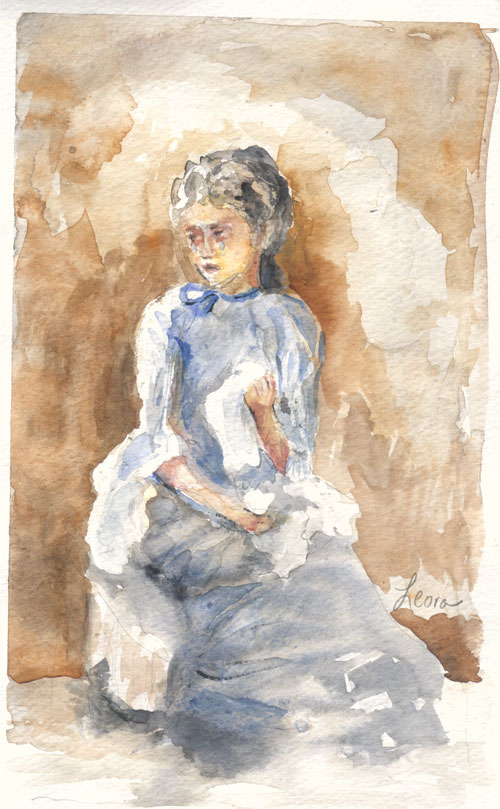
Poor Leah. She cried, because she thought she would get stuck with Esav (Rashi says weak eyes meant they were weak from tears). Instead, she married Yaakov, but she knew that he really loved her sister, Rachel, best.
On Wednesday I asked how Rachel helped out Leah, and how Leah helped out Rachel. Here’s Rashi’s explanation:
Leah helped Rachel out by praying for a girl when she was pregnant with her 7th child. She knew that Yaakov would only have 12 sons, and Bilhah and Zilpah already had 2 each. She wanted Rachel to have at least two sons.
As Lion of Zion pointed out, there are also interpretations that say Leah and Rachel were not so nice to each other. But that’s a subject for another post. Maybe next year.
(One more thought: as I tend to prefer a commentary that is sympathetic to the matriarchs, especially to their sadness, as opposed to one that might highlight cattiness, I’m not sure I’m gonna like these other views).
More on this week’s parsha of Vayetze:
 Ilana-Davita writes about how human the personalities of this parsha are; strong emotions are part of our lives.
Ilana-Davita writes about how human the personalities of this parsha are; strong emotions are part of our lives.
Special thanks to Winslow Homer for his help with the watercolor painting.

This watercolor is available for a limited time (until I do another one I like a lot!) for purchase as a greeting card at my Cafepress store.

This is the watercolor I painted for a post on the age of Rivka. I decided in order to paint I need 1) my children to be out of the house (OK if eldest is home) and 2) not a lot of time. If I have a lot of time, I will fritter it away, checking blogs, doing laundry, running errands, catching up on whatever household stuff I couldn’t get to when I had too much work on my plate.
You will notice the paper is rather rough; it’s fun to experiment with different types of paper. Also, because much of a bride is white, I had to concentrate on the negative space, the parts of the composition that were not bridal veil, dress or flowers.
“Not painting because it’s too much fun is like not going outside on a pretty day because the weather is too nice.” – Sh, a dear friend
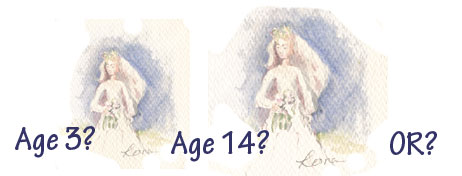
Was Rivka 3 or 14 or some other age when she got married?
 Josh Waxman has much more on this topic.
Josh Waxman has much more on this topic.
But for us in the 21th century, either age seems young. One can see advantages to marrying someone off at fourteen; it (mostly) eliminates the problem with teenage pregnancies, as the girl/woman is married. She was also marrying someone who shared her culture, even if one family worshiped one God and the other worshiped idols. On the other hand, it doesn’t give her anytime to develop a career or even any sense of herself before having children. I can’t even begin to imagine a married 3-year-old, unless it was just a betrothal. Then, married fourteen-year-olds also seems like a strange notion…
This post is a continuation of 100 20 7 14 3. More on the 127, coming soon.